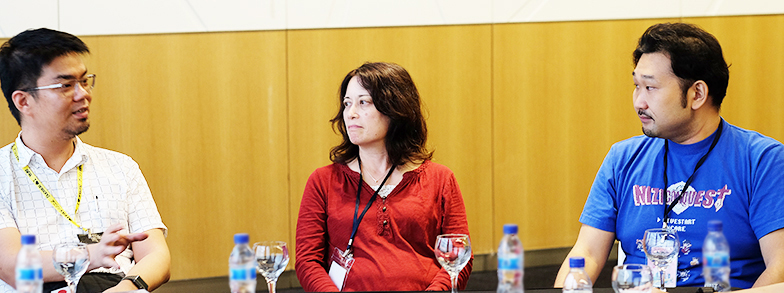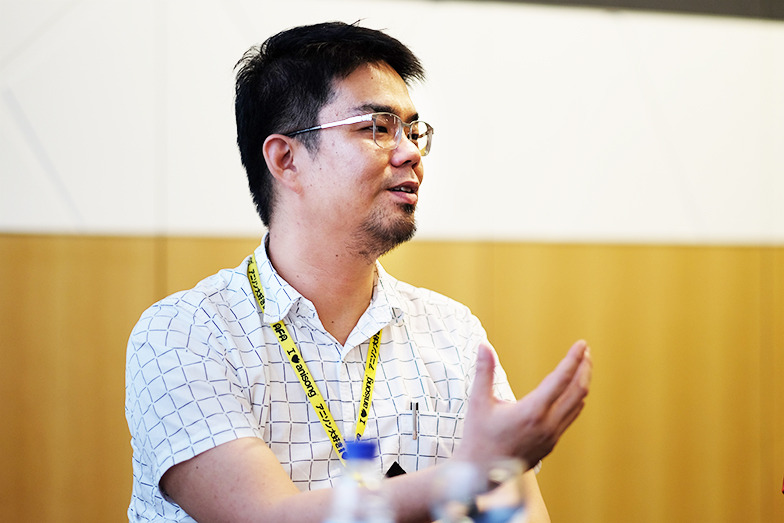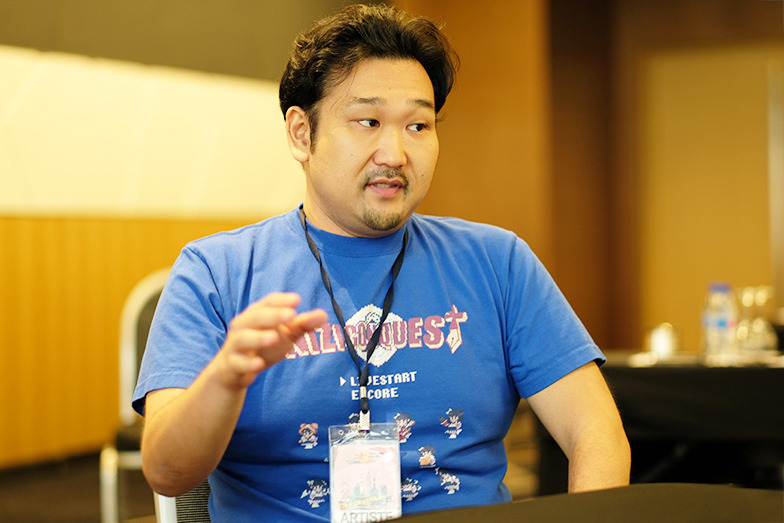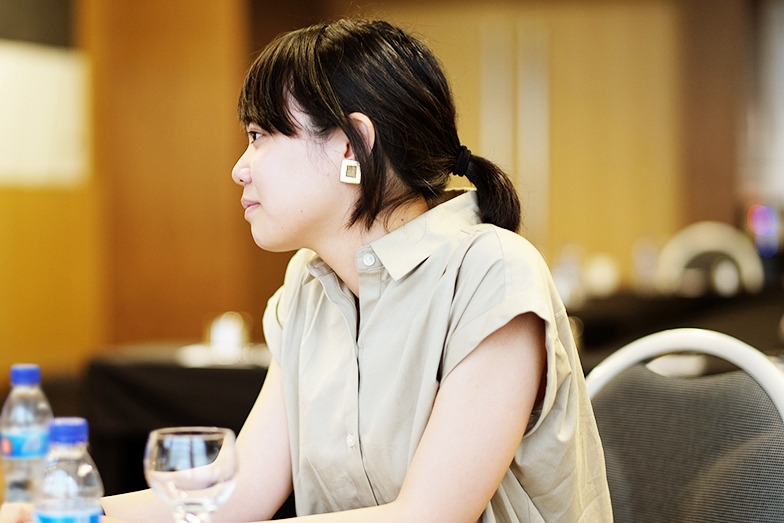Tsuchiya: AFA's defining feature is its all-in-one format combining exhibitions, stages, and concerts. The anime song live shows produced by Zepp feature artists performing 30-45 minute sets, making it viable as a music festival too. Music especially is something that must be experienced live to truly resonate. Fans spread out from the attendees.
Nagata: I believe AFA's defining feature is the proactive nature of participant engagement. While events in Europe and America focus mainly on experiencing and consuming Japanese culture, AFA differs significantly. It's not just about consumption; participants interpret the content, become active communicators themselves, and enjoy that process – a characteristic closer to Japan. AFA is more transparent, with the organizers visible and a close connection to attendees. The physical space fosters interaction among fans. Then, digital platforms like pixiv, web media, and SNS act as supporting elements for the event. It's the synergy between online and offline that generates this energy. Events alone are temporary and eventually fade, but connecting digitally allows that energy to be sustained.
■From Anime Fans to Japan Fans: Singapore's Youth
Suzuki: In terms of attendees, AFA's core demographic is primarily teenagers, right? Merchandise ranges widely from mainstream to moe-style items. What kind of content or artists resonate most with attendees?
Sean: Most start with major works like "Naruto." Later, they develop a taste for deeper, more niche content. Also, Pixiv's "Niji no Conquistador," who performed on the mini-stage this time, is unique. Their selling point is being creators who are also idols, and the members themselves are otaku. Attendees can relate, feeling they're "people like us."
Nagata: Regarding "Niji no Conquistador," idols make the audience feel that emotional connection—wanting to support them and chase dreams together. It's akin to cheering for high school baseball players.
Tsuchiya: For concert artists, attendees first have a favorite anime and come to see the concert featuring its theme song. Then, the moment they see the live performance, they become fans of the artist themselves—including songs beyond the anime theme—and grow from there.
Suzuki: Whether at exhibitions or concerts, even teenagers often have some Japanese reading and speaking skills, creating a lively atmosphere. It feels like they're already familiar with Japan-related content in their daily lives.
Sean: They already love Japan. AFA is made up of people who want to visit Japan, who want to travel there. Above all, their desire to understand their favorite anime more deeply is what drives them to learn Japanese.
Tsuchiya: I think there are many small communities where information is shared. As an artist, the original Japanese is easier to connect with emotionally, and conversely, it often gets across surprisingly well to attendees without needing to be translated back into English.
Nagata: The internet's impact is huge, isn't it? In the past, information had a time lag because it had to be translated and published. Now, with social media, individuals can instantly share and disseminate information.
Suzuki: In Japan, the flow of content popularization follows a spiral: first manga becomes popular, then it's adapted into anime as secondary creations, and eventually gets live-action adaptations. How is it in Singapore or other countries?
Sean: Singapore is the opposite. Anime becomes popular first, then people read the manga. Indonesia and Thailand (which also host AFA) are like Japan, where manga comes first. That trend is noticeable.
Nagata: Manga has its own unique grammar (way of reading), but anime doesn't, so I think it's easier to get into. Plus, adding subtitles to anime is faster than translating and publishing manga. The fact that older works are being animated in a modern style is also really great for spreading globally.
■Toward a "Convenience Store" of Japanese Content, Centered on Anime
Suzuki: This year marks the 8th AFA Singapore. While it's already established as a regular event locally, we must constantly evolve the event itself to retain existing customers while attracting new ones.
Sean: The most important thing is understanding what fans need and continuously providing that. It's crucial they become repeat customers. Furthermore, we must constantly identify new trends and prepare content from different perspectives. Balancing both is essential.
Tsuchiya: For the anime song concerts I organize, I believe we must now focus on nurturing the "next stars." I envision the artists opening this year becoming the headliners in two or three years.
Suzuki: Digital elements are also crucial for building the excitement of events.
Nagata: Comparing it to Japan, Japanese participants aren't just consumers; they're the most active creators and sharers globally. Watching AFA, I feel Singaporeans are incredibly enthusiastic compared to other countries and are catching up to Japan. By having the posting site "pixiv" collaborate with AFA, we want to further accelerate this trend.
Sean: Japan hosts numerous anime-related events year-round. AFA condenses all these Japanese events into three days in Singapore. It's like the convenience store version of anime content. Very simple and accessible. A one-stop Japan, you could say (laughs).
Tsuchiya: Then we're the music department of this convenience store AFA. But Singaporeans will quickly move on to the next thing unless you keep showing them new content. We need to keep creating new stars while constantly thinking about how to present them effectively.
Nagata: Both content and attendee preferences are diversifying. The key is whether people with latent interest can encounter content they love. Can content providers accurately reach fans? I think outreach via the internet, word of mouth, and specialized curation media will become crucial.
Sean: Data is also crucial. While knowing "what" attendees like is important, we need to understand "why" they like it. Amidst this diversification of tastes, we want to incorporate content that resonates with attendees into AFA.
Tsuchiya: Sean, your ability to anticipate trends is truly remarkable.
Suzuki: New additions this year included food and comedy. While anime remains AFA's core, these were hugely popular with attendees.
Sean: When considering the broader umbrella of Made in Japan, that naturally includes Japanese food and fashion. This time, we also featured Yoshimoto comedians and are constantly introducing new elements. For instance, our attempt to link food and anime—like selling nine different parfait flavors inspired by the nine characters from "Love Live!"—resulted in incredibly long lines.
Tsuchiya: If you like all nine, you'd have to eat all nine, right? (laughs)
Suzuki: Food, especially, seems to have a high affinity with anime. If your favorite anime character is eating Japanese food, fans naturally become interested and more likely to like it.
Sean: "Food Wars! Shokugeki no Soma," which Dentsu Inc. was involved with, also became hugely popular as a food anime. Also, introducing comedians this time was a first for us, and we were really worried. But having them perform in Japanese English created a funnier effect than using standard English would have. I believe we need to keep taking on various challenges going forward.
Suzuki: Yes, let's keep experimenting and challenging ourselves next year too. Thank you for today!












